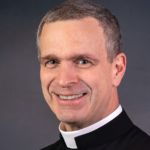
Some are surprised that the doctrine of Mary’s bodily assumption was not defined until 1950, using little biblical support. Pope Pius XII decreed that all Catholics must hold and believe as divinely revealed “that the Immaculate Mother of God, the ever Virgin Mary, completing the course of her earthly life, was assumed body and soul into heavenly glory” (Munificentissimus Deus 44). Yet Tim Perry, an evangelical Protestant, reminds us of the “doctrine’s ancient roots” (239-240).
Although the Bible says nothing directly about the Assumption, it also says nothing about Mary’s life after Pentecost or her death, just as it doesn’t say anything about St. Peter’s and St. Paul’s deaths. But Protestant evangelical Scot McKnight notes that God has the power to assume a person into heaven, and although
we find nothing about Mary’s death or her assumption in the Bible, [does] that mean Mary wasn’t “assumed” into heaven? Obviously not. None of us believes that everything was recorded in the Bible, so we are left to examine the evidence (133).
Jesus addressed similar issues, too—for example, the resurrection from the dead. This was a highly debated topic in his day, especially for the Pharisees, who believed in the resurrection from the dead, and the Sadducees, who did not (see Matt. 22:22). When Jesus addressed their disagreement, he used the Bible, but in an indirect way:
“As for the resurrection of the dead, have you not read what was said to you by God, ‘I am the God of Abraham, and the God of Isaac, and the God of Jacob’? He is not God of the dead, but of the living.” And when the crowd heard it, they were astonished at his teaching (Matt. 22:31-33).
Notice how Jesus used the books of the Bible that the Sadducees accepted—the Torah—and made an inference from them to clarify the question . . . and all were “astonished.”
Later, when Jesus rose from the dead, as the disciples “did not [yet] know the scripture, that he must rise from the dead” (John 20:9), he appeared to them to explain Scripture to them. He did it first with the disciples traveling to Emmaus:
“O foolish men, and slow of heart to believe all that the prophets have spoken! Was it not necessary that the Christ should suffer these things and enter into his glory?” And beginning with Moses and all the prophets, he interpreted to them in all the scriptures the things concerning himself. . . . And their eyes were opened and they recognized him; and he vanished out of their sight. They said to each other, “Did not our hearts burn within us while he talked to us on the road, while he opened to us the scriptures?” (Luke 24:25-27, 31-32).
He had to do it with the apostles, too, to open “their minds to understand the scriptures” (Luke 24:45). But he seems to quote not just one or two passages to them, but “all the scriptures” “beginning with Moses and all the prophets.”
This is how the ancient Church approached Mary’s assumption—not looking for a proof text, but looking to discern whether this teaching was consistent with all the scriptures and with other Christian beliefs. And why wasn’t this teaching “defined” by the Church until the twentieth century? Perhaps the Holy Spirit had waited to counteract the materialistic and mechanistic view propagated by some in the name of science. Mary’s assumption reaffirms the Christian hope in bodily resurrection, attesting to man having a spiritual dimension that endures unto eternity (see also here, at 130-141, and paragraph 974 of the Catechism), which modern science finds absurd. As St. Paul writes,
the trumpet will sound, and the dead will be raised imperishable, and we shall be changed. For this perishable nature must put on the imperishable, and this mortal nature must put on immortality. . . . Then shall come to pass the saying that is written: “Death is swallowed up in victory.” “O death, where is thy victory? O death, where is thy sting?” (1 Cor. 15:52-55, quoting Isa. 25:8 and Hos. 13:14).
This certainly applied to some Old Testament saints who were assumed into heaven: Enoch (Gen. 5:22-24, Sir. 49:14, Heb. 11:5-6), Moses (Jude 8-10, Deut. 34:5-6, 10-12), and Elijah (2 Kings 2:11-13). If any woman or man ought to be taken into heaven, body and soul, it would be Mary, the holy Mother of God.
Examining the evidence, prefigured in the Old Testament, the Holy Spirit guided the early Christians to conclude that Mary—the mother of the Messiah, the Ark of the New Covenant (Rev. 11:19-12:5)—is a woman in heaven, clothed with the sun’s glory, crowned with twelve stars, and with the moon under her feet. This means she is certainly alive, body and soul, in heaven. As Pius XII says:
The revered Mother of God, from all eternity joined in a hidden way with Jesus Christ . . . immaculate in her conception, a most perfect virgin in her divine motherhood, the noble associate of the divine Redeemer who has won a complete triumph over sin and its consequences . . . [was granted] that she should be preserved free from the corruption of the tomb (Munificentissimus Deus 40).
Twice I have been on pilgrimage to the Holy Land, where we were able to visit many of the places where events of our Lord’s life and of his blessed mother’s life took place. One special one was the Cenacle and alongside it the Church of the Dormition.
We know that St. John the Apostle took care of Mary, the Mother of God, after our Lord’s ascension. John remained in Jerusalem with Mary until Herod’s persecution, detailed in Acts 12:1-3. Then John took the Virgin Mary with him to Ephesus. The two returned to Jerusalem after the death of Herod and supported the Church as she grew in number and extension. Likely she was back there with John at the Council of Jerusalem in the year 50, described in Acts 15.
In Jerusalem, Mary often would do the Way of the Cross and pray in front of the Holy Sepulcher as a way of uniting herself to her son. This reinforced her desire to be like him in dying for love. The Eastern churches celebrate the feast of Mary’s dormition, describing the fulfillment of her desire to die with Christ more like falling asleep than as dying.
Church Fathers and sacred writers, beginning in the second century with Bishop St. Melito of Sardis (who died around A.D. 200), give us details of Our Lady’s dormition and assumption. These traditions tell us that Mary, knowing she was about to leave this world, called together the apostles, except St. James, who had been martyred.
All the apostles (except for St. Thomas, who had yet to arrive from distant India) gathered around Mary while she lay on her bed. As she gave them encouragement in their apostolic endeavors, Jesus appeared to her. She looked up and said his name. Then she closed her eyes, entrusted her soul to her son, and breathed her last.
Large crowds of faithful gathered around Mary’s body as the apostles carried the funeral bier in solemn procession from the house of the Dormition on Mount Zion to the tomb just a stone’s throw north of Gethsemane. As they carried her bier up the Kidron Valley (Valley of Josaphat), a Jewish priest named Athonios was filled with anger and jealousy and tried to topple the bier with the body of the Mother of God. When Athonios touched the bier with his two hands, an angel cut off both hands instantaneously. Repenting of his misdeed and declaring the greatness of God and of Mary, he was healed.
They arrived at the tomb near the Garden of Gethsemane, in the same plot where her parents Joachim and Anna were buried. Upon sealing the tomb, many of the Christian faithful remained outside praying. Some described hearing the sound of angels singing, which is associated with Mary’s assumption and the source of her title “St. Mary of the Angels.”
Tradition has it that St. Thomas arrived to Jerusalem from India three days later and was quite disappointed that he had not been able to accompany Mary in her last moments. So the apostles took Thomas to Mary’s tomb, where he prostrated himself. Opening the tomb for him, they found it empty except for the burial clothes that had wrapped Our Lady’s body. Again, celestial music could be heard.
Mary’s assumption reaffirms our faith in the resurrection of the body, giving us hope in eternal life with Christ, and with our heavenly Mother, in heaven.



